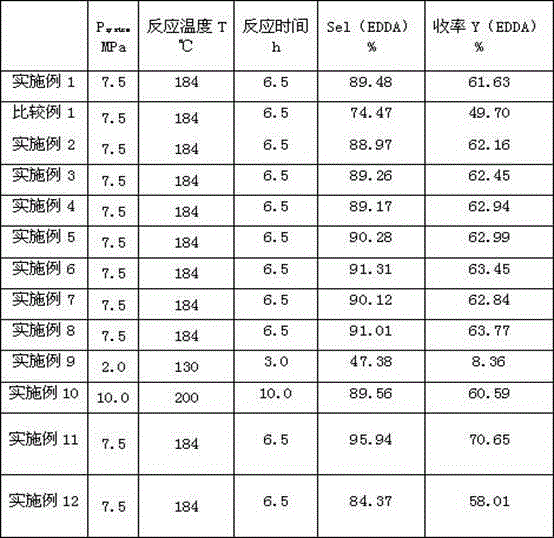Catalyst used in synthesis of ethylidene diacetate
A technology of ethylene diacetate and catalyst, applied in the direction of organic compound/hydride/coordination complex catalyst, physical/chemical process catalyst, organic chemistry, etc., can solve the problem of low yield of ethylene diacetate, diacetic acid The problems of high selectivity and low selectivity of ethylene ester can achieve the effect of improving yield and selectivity, improving activity and stability
- Summary
- Abstract
- Description
- Claims
- Application Information
AI Technical Summary
Problems solved by technology
Method used
Image
Examples
Embodiment 1
[0027] Synthesis of diethylene acetate: 1.5mol acetic acid, 0.06mol RhCl 8 , 0.15molCH 3 I, 0.045mol structure (II) imidazole type NHC (its synthesis method is according to literature Arduengo A J, Harlow R L, Kline M.J. Am.Chem.Soc., 1991,113:361-363) and 0.45mol methyl acetate add 1.5L titanium In the material reactor, in which, in molar ratio, RhCl 8 :CH 3 I: Accelerator is 1:2.5:0.75 (where iodide is calculated as I atom). First use argon to exhaust the air in the kettle, then pressurize to 2.0MPa, then introduce carbon monoxide and hydrogen until the pressure is 7.5MPa, increase the stirring speed to 1500rpm, and at the same time stir and heat up to the reaction temperature, control the reaction temperature to 184 ° C, carbon monoxide and hydrogen The molar ratio was 2:1, and the reaction was stopped after 6.5 hours of continuous reaction.
[0028] Product analysis: The reaction mixture obtained from the above reaction was cooled, decompressed, and separated, and the ...
Embodiment 2
[0036] Synthesis of diethylene acetate: 1.5mol acetic acid, 0.06mol RhCl 8, 0.15molLiI, 0.045mol structure (III) imidazoline-type NHC (its synthesis method is based on the literature Arduengo A J, Harlow R L, Kline M.J. Am.Chem.Soc., 1991,113: 361-363) and 0.45mol methyl acetate were added In a 1.5L titanium reactor, RhCl is in molar ratio 8 : LiI: Accelerator is 1:2.5:0.75 (where iodide is calculated as I atom). First use argon to exhaust the air in the kettle, then pressurize to 2.0MPa, then introduce carbon monoxide and hydrogen until the pressure is 7.5MPa, increase the stirring speed to 1500rpm, and at the same time stir and heat up to the reaction temperature, control the reaction temperature to 184 ° C, carbon monoxide and hydrogen The molar ratio was 2:1, and the reaction was stopped after 6.5 hours of continuous reaction.
[0037] Product analysis: The reaction mixture obtained from the above reaction was cooled, decompressed, and separated, and the liquid phase was...
Embodiment 3
[0040] The synthesis of diethylene acetate: 1.5mol acetic acid, 0.06mol RhCl8, 0.15molHI, 0.045mol structure (IV) triazole type NHC (its synthetic method is according to literature Arduengo A J, Harlow R L, Kline M.J. Am.Chem.Soc. , 1991,113: 361-363) and 0.45mol methyl acetate were added to a 1.5L titanium reactor, wherein in molar ratio, RhCl 8 : HI: Accelerator is 1:2.5:0.75 (where iodide is calculated as I atom). First use argon to exhaust the air in the kettle, then pressurize to 2.0MPa, then introduce carbon monoxide and hydrogen until the pressure is 7.5MPa, increase the stirring speed to 1500rpm, and at the same time stir and heat up to the reaction temperature, control the reaction temperature to 184 ° C, carbon monoxide and hydrogen The molar ratio was 2:1, and the reaction was stopped after 6.5 hours of continuous reaction.
[0041] Product analysis: The reaction mixture obtained from the above reaction was cooled, decompressed, and separated, and the liquid phase ...
PUM
 Login to View More
Login to View More Abstract
Description
Claims
Application Information
 Login to View More
Login to View More - R&D
- Intellectual Property
- Life Sciences
- Materials
- Tech Scout
- Unparalleled Data Quality
- Higher Quality Content
- 60% Fewer Hallucinations
Browse by: Latest US Patents, China's latest patents, Technical Efficacy Thesaurus, Application Domain, Technology Topic, Popular Technical Reports.
© 2025 PatSnap. All rights reserved.Legal|Privacy policy|Modern Slavery Act Transparency Statement|Sitemap|About US| Contact US: help@patsnap.com

